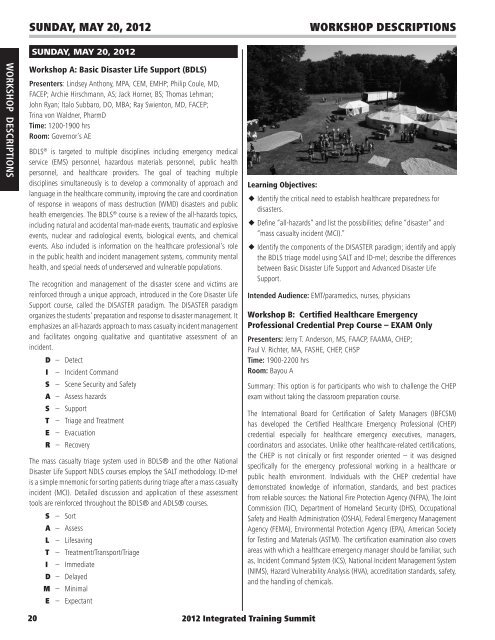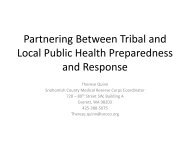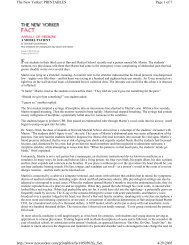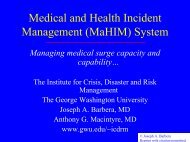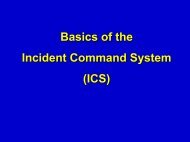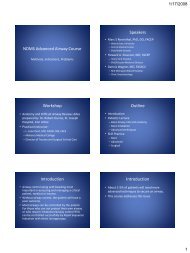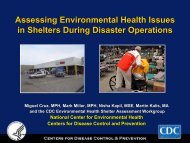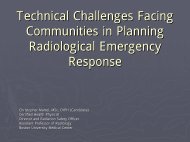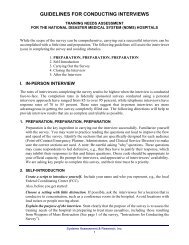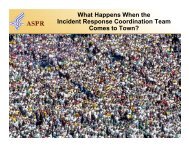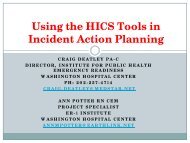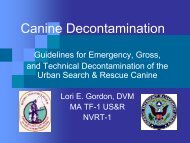Sunday, May 20, <strong>2012</strong>Workshop DescriptionsWorkshop DescriptionsSunday, May 20, <strong>2012</strong>Workshop A: Basic Disaster Life Support (BDLS)Presenters: Lindsey Anthony, MPA, CEM, EMHP; Philip Coule, MD,FACEP; Archie Hirschmann, AS; Jack Horner, BS; Thomas Lehman;John Ryan; Italo Subbaro, DO, MBA; Ray Swienton, MD, FACEP;Trina von Waldner, PharmDTime: 1200-1900 hrsRoom: Governor’s AEBDLS ® is targeted to multiple disciplines including emergency medicalservice (EMS) personnel, hazardous materials personnel, public healthpersonnel, and healthcare providers. <strong>The</strong> goal of teaching multipledisciplines simultaneously is to develop a commonality of approach andlanguage in the healthcare community, improving the care and coordinationof response in weapons of mass destruction (WMD) disasters and publichealth emergencies. <strong>The</strong> BDLS ® course is a review of the all-hazards topics,including natural and accidental man-made events, traumatic and explosiveevents, nuclear and radiological events, biological events, and chemicalevents. Also included is information on the healthcare professional’s rolein the public health and incident management systems, community mentalhealth, and special needs of underserved and vulnerable populations.<strong>The</strong> recognition and management of the disaster scene and victims arereinforced through a unique approach, introduced in the Core Disaster LifeSupport course, called the DISASTER paradigm. <strong>The</strong> DISASTER paradigmorganizes the students’ preparation and response to disaster management. Itemphasizes an all-hazards approach to mass casualty incident managementand facilitates ongoing qualitative and quantitative assessment of anincident.D – DetectI – Incident CommandS – Scene Security and SafetyA – Assess hazardsS – SupportT – Triage and TreatmentE – EvacuationR – <strong>Recovery</strong><strong>The</strong> mass casualty triage system used in BDLS® and the other NationalDisaster Life Support NDLS courses employs the SALT methodology. ID-me!is a simple mnemonic for sorting patients during triage after a mass casualtyincident (MCI). Detailed discussion and application of these assessmenttools are reinforced throughout the BDLS® and ADLS® courses.S – SortA – AssessL – LifesavingT – Treatment/Transport/TriageI– ImmediateD – DelayedM – MinimalE – ExpectantLearning Objectives:u Identify the critical need to establish healthcare preparedness fordisasters.u Define “all-hazards” and list the possibilities; define “disaster” and“mass casualty incident (MCI).”u Identify the components of the DISASTER paradigm; identify and applythe BDLS triage model using SALT and ID-me!; describe the differencesbetween Basic Disaster Life Support and Advanced Disaster LifeSupport.Intended Audience: EMT/paramedics, nurses, physiciansWorkshop B: Certified Healthcare EmergencyProfessional Credential Prep Course – EXAM OnlyPresenters: Jerry T. Anderson, MS, FAACP, FAAMA, CHEP;Paul V. Richter, MA, FASHE, CHEP, CHSPTime: 1900-2200 hrsRoom: Bayou ASummary: This option is for participants who wish to challenge the CHEPexam without taking the classroom preparation course.<strong>The</strong> International Board for Certification of Safety Managers (IBFCSM)has developed the Certified Healthcare Emergency Professional (CHEP)credential especially for healthcare emergency executives, managers,coordinators and associates. Unlike other healthcare-related certifications,the CHEP is not clinically or first responder oriented – it was designedspecifically for the emergency professional working in a healthcare orpublic health environment. Individuals with the CHEP credential havedemonstrated knowledge of information, standards, and best practices<strong>from</strong> reliable sources: the National Fire Protection Agency (NFPA), <strong>The</strong> JointCommission (TJC), Department of Homeland Security (DHS), OccupationalSafety and Health Administration (OSHA), Federal Emergency ManagementAgency (FEMA), Environmental Protection Agency (EPA), American Societyfor Testing and Materials (ASTM). <strong>The</strong> certification examination also coversareas with which a healthcare emergency manager should be familiar, suchas, Incident Command System (ICS), National Incident Management System(NIMS), Hazard Vulnerability Analysis (HVA), accreditation standards, safety,and the handling of chemicals.20<strong>2012</strong> Integrated Training Summit
Monday, May 21, <strong>2012</strong>Workshop DescriptionsMonday, MAy 21, <strong>2012</strong>Workshop C: Advanced Disaster Life Support (ADLS)Presenters: Lindsey Anthony, MPA, CEM, EMHP; Philip Coule, MD,FACEP; Archie Hirschmann, AS; Jack Horner, BS; Thomas Lehman;John Ryan; Italo Subbaro, DO, MBA; Ray Swienton, MD, FACEP;Trina von Waldner, PharmDTime: 0800-1700 hrs (16-hour workshop, continued Tuesday, May 22,0800-1700 hrs)Room: Governor’s AEADLS ® is an advanced practicum course for the trained BDLS ® provider.It is an intensive, two-day course that allows students to demonstratecompetencies in casualty decontamination, specified essential skills, andmass casualty incident information systems and technology applications.Using simulated, all-hazards scenarios and mass casualty incidents, ADLS ®makes use of four interactive sessions in which participants treat simulatedpatients in various disaster drills and situations. Training is focused on thedevelopment of hands-on skills to allow participants to apply the knowledgelearned in BDLS ® .ADLS ® ’s interactive scenarios and drills utilize high-fidelity mannequins andvolunteer patients to simulate a realistic experience in treating pathologicpatient conditions not routinely encountered by responders and healthcareproviders. Hands-on exercises teach practical skills, such as decontaminationand use of protective equipment, and provide instruction in topics thattraditionally are not addressed in healthcare education curricula.Day 2 of ADLS ® is the hands-on day of training. Four skills stations reinforcethe previous day’s learning. <strong>The</strong>se skills stations are as follows:MASS Triage. This challenging station allows students to practice theconcepts of the disaster paradigm with an emphasis on patient triage.Simulated disaster victims must be triaged and treated correctly whilestudents attempt to manage a chaotic scene and request appropriateresources.Personal Protective Equipment (PPE) and Decontamination. Thisstation teaches important concepts about the use of personal protectiveequipment (PPE) and decontamination technique. Students are given theopportunity to wear PPE and participate in a simulated decontaminationwhile attempting to render medical care.Disaster Skills. This station teaches information about vital skillsnecessary for medical disaster management. Students are taught aboutthe Strategic National Stockpile and proper Mark-I kit use. Students alsopractice smallpox immunization.Human Patient Simulator. Recognition of victims of a chemical andbiological disaster is paramount. This station is designed to reinforcethe detection and proper treatment of conditions that may occur duringdisasters that participants do not normally treat. Treatment of chemical,biological, and traumatic patients is covered. <strong>The</strong> use of high-fidelityhuman patient simulators allows the student to see, hear, and feelinformation that would normally be provided by an instructor, creating amore realistic experience than standard mannequins can provide.Learning Objectives:u Apply the BDLS DISASTER paradigm to respond to various disasterscenarios and treat simulated patients using high-fidelity mannequins.u Apply the BLDS triage model utilizing M.A.S.S. and ID-me!;demonstrate decontamination techniques for disaster scenarios withcontaminated casualties and the correct use of personal protectiveequipment (PPE) for various hazardous scenarios.u Practice the use of autoinjectors for the treatment of chemicalcasualties; practice smallpox immunization with bifurcated needles;obtain information about the Strategic National Stockpile at a DisasterSkills station.Intended Audience: EMT/paramedics, nurses, physiciansWorkshop D: Navigation Skills for Disaster ResponsePresenter: Ben Ho, MDTime: 0800-1200 hrsRoom: Bayou EAll response team members deploying to disasters need to understand thefundamentals of land navigation as well as the newly mandated U.S. NationalGrid System. Whether DMAT, DMORT, NVRT, or USAR, personnel shouldalways know where they are, how to return, how to direct others, and howto identify the location of victims, medical facilities, landing zones, and otherkey landmarks. This concentrated workshop will teach the basics of typicalnavigation skills and tools, map and compass, and new devices and aids.Using actual case histories <strong>from</strong> previous disaster deployments, the coursewill also cover signage, route finding, pattern recognition, and map data,as well as the practical application of these concepts in the altered disasterenvironment. <strong>The</strong> workshop will additionally review the fundamentals ofthe U.S. National Grid System (USNGS). Due to the limitations of class size,indoor conference facilities, and equipment variability and availability, fieldtraining will not be possible. Further practical experience in this perishableskill is highly encouraged for all team members at home.Learning Objectives:u Describe the basics of land navigation.u Apply the basics of land navigation in disasters.u Explain the U.S. National Grid System.Intended Audience: Certified counselors, dentists, emergencyphysicians, EMT/paramedics, environmental health personnel, healthcareexecutives, health education specialists, industrial hygienists, marriage &family therapists, medical administrators, morticians, nurses, physicians,respiratory therapists, social workers, veterinarians<strong>2012</strong> Integrated Training Summit 21Workshop Descriptions
- Page 1 and 2: Leading from PreparednessThrough Re
- Page 3 and 4: Table of ContentsAmericans with Dis
- Page 5 and 6: Integrated Training Summit Partner
- Page 7 and 8: Focus area DescriptionsFocus Area D
- Page 9 and 10: Late Breakers & Early RisersTuesday
- Page 11 and 12: Handy Perforated Daily Agendas - De
- Page 13 and 14: Handy Perforated Daily Agendas - De
- Page 15 and 16: Handy Perforated Daily Agendas - De
- Page 17 and 18: Handy Perforated Daily Agendas - De
- Page 19: WorkshopDescriptions2012 Integrated
- Page 23 and 24: MoNday, May 21, 2012Workshop Descri
- Page 25 and 26: MoNday, May 21, 2012Workshop Descri
- Page 27 and 28: Tuesday, May 22, 2012Workshop Descr
- Page 29 and 30: WEDNESday, May 23, 2012dMIS Worksho
- Page 31 and 32: ThurSday, May 23, 2012dMIS Workshop
- Page 33 and 34: SessionDescriptionssession Descript
- Page 35 and 36: wednesday, May 23, 2012Session Desc
- Page 37 and 38: wednesday, May 23, 2012Session Desc
- Page 39 and 40: wednesday, May 23, 2012u Provide ex
- Page 41 and 42: wednesday, May 23, 2012Session Desc
- Page 43 and 44: wednesday, May 23, 2012Session Desc
- Page 45 and 46: Thursday, May 24, 2012Session Descr
- Page 47 and 48: THURsday, May 24, 2012Session Descr
- Page 49 and 50: THURsday, May 24, 2012Session Descr
- Page 51 and 52: THURsday, May 24, 2012Session Descr
- Page 53 and 54: THURsday, May 24, 2012Session Descr
- Page 55 and 56: THURsday, May 24, 2012Session Descr
- Page 57 and 58: FRIday, May 25, 2012Session Descrip
- Page 59 and 60: Tuesday, May 22, 2012MRC WorkshopsM
- Page 61 and 62: Tuesday, May 22, 2012MRC WorkshopsL
- Page 63 and 64: Continuing Education InformationCon
- Page 65 and 66: Continuing Education InformationSes
- Page 67 and 68: Planning CommitteeDawn AnastasiaChe
- Page 69 and 70: PresentersBrian Abrahamson, BAGaylo
- Page 71 and 72:
PresentersMary Massey, BSN, MA, MEP
- Page 73 and 74:
Presenter DisclosuresAlliance betwe
- Page 75 and 76:
2012 Poster PresentationsMRCPoster
- Page 77 and 78:
2012 Poster PresentationsApplicatio
- Page 79 and 80:
2012 Poster PresentationsCollaborat
- Page 81 and 82:
2012 Poster PresentationsEducation
- Page 83 and 84:
2012 Poster PresentationsSpecial Co
- Page 85 and 86:
Integrated Training Summit Acronym


